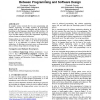612 search results - page 16 / 123 » Bridging the Gap between Systems Design |
TACAS
2010
Springer
13 years 5 months ago
2010
Springer
Abstract. Intermediate languages are a paradigm to separate concerns in software verification systems when bridging the gap between programming languages and the logics understood ...
DSD
2006
IEEE
14 years 1 months ago
2006
IEEE
System Level Design (SLD) is widely seen as a solution for bridging the gap between chip complexity and design productivity of Systems on Chip (SoC). SLD relieves the designer fro...
VSTTE
2005
Springer
14 years 29 days ago
2005
Springer
We formulate some research and development challenges that relate what a verifying compiler can verify to the definition and analysis of the application-content of programs, where...
ICSE
2008
IEEE-ACM
14 years 8 months ago
2008
IEEE-ACM
In computer science curricula the two areas programming and software engineering are usually separated. In programming students learn an object oriented language and then deepen t...
IWC
2011
13 years 2 months ago
2011
The importance of adopting a socio-technical approach to system development is recognised by many but not widely practised. We analyse the reasons for this, considering the histor...


